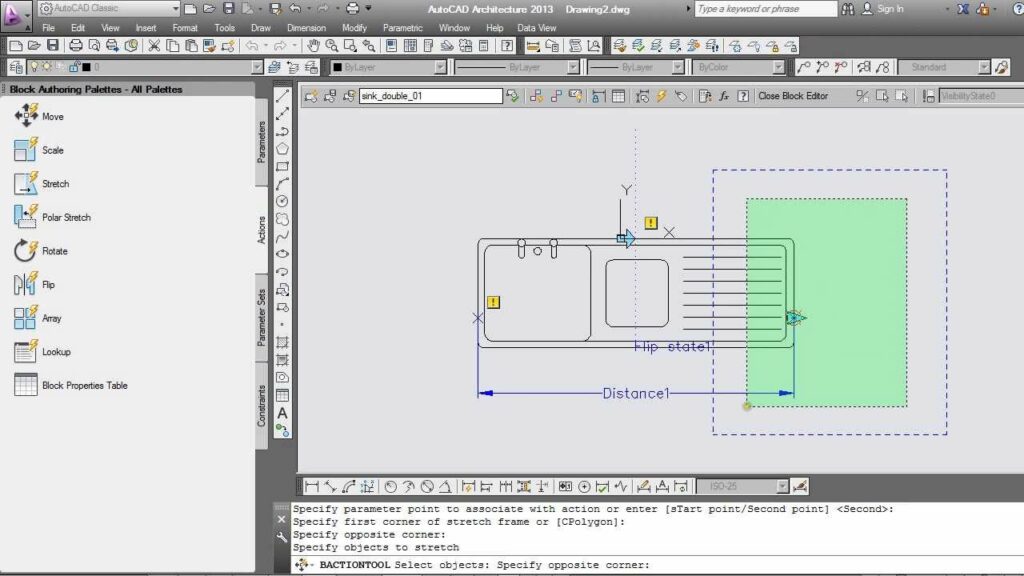Mastering AutoCAD: A Comprehensive Guide to Using Dynamic Blocks

In the realm of computer-aided design (CAD), dynamic blocks in AutoCAD represent a powerful tool for creating intelligent and flexible block references. Dynamic blocks allow users to incorporate parametric behavior, multiple configurations, and interactive elements into block instances, enabling greater flexibility, efficiency, and customization in design projects. Whether you’re an architect, engineer, designer, or drafting professional, understanding how to effectively use dynamic blocks empowers you to streamline workflows, enhance productivity, and create dynamic and interactive designs. In this comprehensive guide, we’ll explore the tools and techniques for using dynamic blocks in AutoCAD, discuss their applications and functionalities, and provide step-by-step instructions to help you refine your drafting skills and unlock new possibilities in your design projects.
Understanding Dynamic Blocks in AutoCAD:
Before delving into the specifics of using dynamic blocks in AutoCAD, it’s essential to grasp the concepts and functionalities of dynamic blocks:
- Parametric Behavior: Dynamic blocks in AutoCAD incorporate parametric relationships and constraints that allow block geometry and properties to be dynamically adjusted based on predefined parameters and actions.
- Multiple Configurations: Dynamic blocks can contain multiple configurations or states, allowing users to define and switch between different variations of a block instance without the need to create separate block definitions.
- Interactive Elements: Dynamic blocks can include interactive elements such as grips, parameters, and actions that enable users to interactively modify block geometry, visibility, and properties within the drawing environment.
Using Dynamic Blocks in AutoCAD:
AutoCAD provides a variety of tools and commands for creating, editing, and using dynamic blocks, allowing users to harness the full potential of dynamic block functionality. Here’s how to use dynamic blocks in AutoCAD:
- Creating Dynamic Blocks:
- To create a dynamic block in AutoCAD, start by creating a standard block definition containing the desired geometry and properties.
- Enter the Block Editor by typing “BEDIT” in the command line or double-clicking on a block reference within the drawing.
- Use the Block Editor tools and commands to add parametric relationships, constraints, and actions to the block definition, defining how the block will behave dynamically.
- Exit the Block Editor to save the dynamic block definition and return to the drawing.
- Inserting Dynamic Blocks:
- To insert a dynamic block into a drawing, use the Insert command or drag and drop the dynamic block from the Block Palette or Design Center.
- After inserting the dynamic block, use grips, parameters, and actions to interactively modify the block geometry, visibility, and properties within the drawing environment.
Advanced Techniques for Using Dynamic Blocks:
In addition to basic dynamic block tools and commands, AutoCAD offers advanced techniques for optimizing dynamic block usage and enhancing productivity:
- Parameter Sets: Define parameter sets within dynamic blocks to organize and manage related parameters, allowing users to switch between different configurations or states of the block instance.
- Visibility States: Create visibility states within dynamic blocks to control the visibility of block components based on user-defined conditions or actions, enabling users to show or hide specific geometry or properties as needed.
- Lookup Tables: Utilize lookup tables within dynamic blocks to associate parameter values with predefined data tables, allowing users to quickly apply standard configurations or properties to block instances.
- Nested Dynamic Blocks: Create nested dynamic blocks by embedding one dynamic block within another, enabling users to build complex assemblies and hierarchical structures with interactive elements and parametric behavior.
Best Practices for Using Dynamic Blocks:
To maximize efficiency and maintain consistency when using dynamic blocks in AutoCAD, consider implementing the following best practices:
- Plan Block Functionality: Before creating dynamic blocks, carefully plan the desired functionality, parameters, and actions to ensure that the dynamic block meets the specific requirements of your design project.
- Organize Parameters: Organize parameters logically within dynamic blocks by grouping related parameters and organizing them into parameter sets, making it easier to manage and modify block behavior.
- Test Interactivity: Test the interactivity and functionality of dynamic blocks in different design scenarios to verify that the block behaves as intended and responds correctly to user actions and input.
- Document Block Usage: Document the usage and functionality of dynamic blocks within drawings or project documentation to facilitate collaboration and ensure consistent interpretation by other users.
Conclusion:
Mastering the techniques for using dynamic blocks in AutoCAD is essential for enhancing productivity, streamlining workflows, and creating dynamic and interactive designs. By understanding the concepts and functionalities of dynamic blocks, practicing their use in different design scenarios, and implementing best practices for efficiency and consistency, you can elevate your drafting skills and unlock new possibilities in your design projects. Whether you’re creating architectural plans, mechanical drawings, or electrical schematics, knowing how to effectively use dynamic blocks will enable you to produce high-quality designs with flexibility and precision. With dedication, practice, and a commitment to continuous learning, you’ll become proficient in using dynamic blocks in AutoCAD and excel in your CAD design endeavors.




